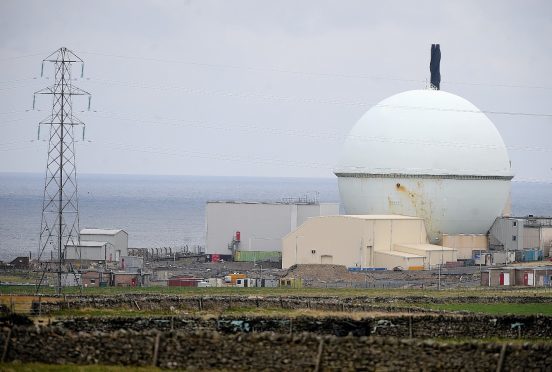Campaigners last night warned the UK Government not to risk “playing ping pong” across the Atlantic with radioactive material.
As revealed in the Press and Journal in December, nuclear waste from Dounreay is to be transported to the United States.
About 1,540lb (700kg) of highly-enriched uranium (HEU) will be sent from the Caithness storage facility in the largest-ever consignment of its kind.
In return, a different form of the element will be transferred to the European atomic energy agency Euratom for conversion to medical isotopes used to diagnose and treat cancer.
The UK Government confirmed yesterday a deal had been struck and David Cameron will set out the details in Washington where he is attending the International Nuclear Security Summit.
Officials would not comment on the planned mode of transport of the material however, citing security reasons.
SNP MP Paul Monaghan branded the deal “morally reprehensible”, raising concerns about the possibility of flights carrying “highly toxic materials” out of Wick Airport.
Campaigners also warned of the dangers of transporting the waste by sea, particularly in the context of the uncertainty over the future of the single remaining Emergency Towing Vessel (ETV).
And the Westminster government was accused of being “at best misleading and at worst cynical” in presenting the proposal as helping in the fight against cancer.
Highland Council leader Councillor Margaret Davidson said the development raised the risk of a “potentially catastrophic incident to unacceptable levels”.
She added: “The Pentland Firth is notorious for the challenges it poses in terms of weather, tides and navigation.
“There needs to be adequate protection in place to respond in the case of an incident whilst the waste is being transported.”
Councillor Richard Greene, vice-chairman of the local authority’s community services committee, suggested some of the money from the deal should be used to fund additional tugs.
Mr Monaghan said the cash value of 700kg HEU could be in the region of £1billion.
Richard Dixon, director of Friends of the Earth Scotland, insisted nuclear waste should be dealt with as close as possible to where it was produced.
He added: “Only the nuclear industry could think it was a good idea to risk playing ping pong with large quantities of one of the most dangerous materials on the planet across the Atlantic.
“Europe is littered with plenty of highly radioactive waste from both reactors and weapons, there cannot possibly be a need to be importing any more from the US, nor for us to be sending ours to them.
“This waste will remain dangerous for tens of thousands of years. The consequences of an accident during transit would be horrific.”
The Scottish Greens’ Highlands and Islands Holyrood candidate John Finnie said there had to be better ways to fight cancer than “sending dangerous uranium on a 6,800-mile round trip”.
He added: “The attempt to present the proposal to send dangerous nuclear waste across the Atlantic as helping in the fight against cancer is at best misleading and at worst cynical.”
Confirming the news, a UK Government source said: “The prime minister will be announcing a landmark deal we have agreed with the United States and with Euratom, the European atomic energy agency, to turn nuclear waste into cancer-fighting treatment.
“It’s a win-win – we get rid of waste and we get back something that will help us to fight cancer.”
The HEU being sent by the US will be processed in France for use in hospitals across Europe.
MP to write to David Cameron
Caithness MP Paul Monaghan said last night he would be writing to David Cameron for clarification on how the nuclear waste would be transported from Dounreay.
He raised concerns about a deal at the end of last year when SNP Westminster leader Angus Robertson also brought up the issue at Prime Minister’s Questions.
Asked whether there was a plan on the table to fly nuclear weapons-grade uranium out of Wick Airport, George Osborne – who was standing in – simply pointed to the existing, established transportation procedures.
Mr Monaghan said afterwards that this reply had been followed up with a letter from Mr Cameron denying there were any plans to move weapons-grade uranium – intended for use in nuclear missiles – from Dounreay.
Yesterday, the SNP MP told the Press and Journal he was “unfortunately” unsurprised by the latest development.
He added: “It is now certain that these highly toxic and dangerous materials will be moving backwards and forwards across the Atlantic.”
He welcomed the continuation of the decommissioning process and the transfer of highly enriched uranium out of Dounreay “where it should never have been held in the first place”.
But he added: “The chief concern I have now is the mode of transport that will be used. At the moment, there is a shortage of emergency towing vessels.
“I remain concerned about the possibility of flights out of Wick John O’Groats Airport carrying these highly toxic radioactive materials.
“I will write to the prime minister as soon as possible to seek clarification on the mode of transport and how risk assessment and management arrangements will be put in place to protect the people of my constituency and indeed Scotland.”
The Nuclear Decommissioning Authority said the Dounreay Site Licence Company was developing options for the transport of the material, but that no final decision had been taken on the preferred method or route.
Calling the deal “morally reprehensible”, Mr Monaghan said: “We need to be clear the purpose of HEU is for use in nuclear weapons.
“The transfer of medical isotopes from the US to the UK is obviously something that should be welcomed, but not as part of a swap to facilitate the production of nuclear weapons.”
A UK government source previously told the Press and Journal no material travelling to the US would end up in missiles as nuclear nations were not allowed to transport material from one place to another for weapons.










